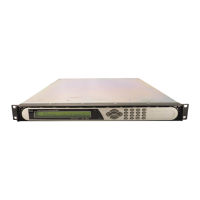4023074 Rev B Model D9858 Advanced Receiver Transcoder Installation and Operation Guide 4-29
Setup Menu: TS Input: Input: RF1-RF4
LO1
Description: This is the Local Oscillator frequency #1. This option sets the
satellite antenna LNB local oscillator #1 frequency.
Parameters: 0.0 to 15.0 GHz. Must be lower than the value for LO2.
LO2
Description: This is the Local Oscillator frequency #2. It sets the satellite antenna
LNB local oscillator #2 frequency. This option is only used in dual-
band LNB applications.
Parameters: 0.0 to 15.0 GHz. Must be higher than the value for LO1. In single-
band LNB applications, set this value to 0.0.
XOver
Description: This is the crossover frequency, which is an internal threshold
frequency used for selecting the LO1 or LO2 frequency, depending
on the current Downlink frequency settings. This option is only
used in dual-band LNB applications.
Parameters: 0.0 to 15.0 GHz.
In single-band LNB applications, set this value to 0.0.
Satellite
Description: This is the name of the satellite currently selected. Choose the
satellite you want to use to receive the signal from the list of
satellites available. When you select a satellite, the orbital position
(OrbPos) is displayed. This is important for automatic switching
from one RF input to another in the event of loss of the signal,
allowing the transcoder to acquire an alternate signal.
Parameters: When the satellite is not listed, enter the known orbital position
(OrbPos) of the satellite you want to use to receive the signal.
OrbPos
Description: This is the location in orbit of the satellite currently being used. The
satellite position (in degrees) in combination with the direction
(either E (East) or W (West)) denotes the satellite position the dish
connected to the current RF Input should point. This is used when
the satellite is not available in the look-up menu list.
Parameters: For manual configuration, simply enter the location of the satellite
using the numerical keypad. The transcoder will not recognize the
satellite name and identify it as Unknown. This setting is required
to resolve any ambiguity between RF inputs during automatic
disaster recovery.
Parameters: Degrees.

